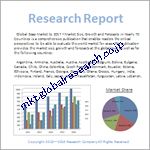目次
第1章.建築物一体型太陽光発電の世界市場 エグゼクティブサマリー
1.1.建築物一体型太陽光発電の世界市場規模・予測(2022~2032年)
1.2.地域別概要
1.3.セグメント別概要
1.3.1.技術別
1.3.2.用途別
1.3.3.最終用途別
1.4.主要動向
1.5.不況の影響
1.6.アナリストの提言と結論
第2章.世界の建築物一体型太陽光発電市場の定義と調査前提
2.1.調査目的
2.2.市場の定義
2.3.調査の前提
2.3.1.包含と除外
2.3.2.限界
2.3.3.供給サイドの分析
2.3.3.1.入手可能性
2.3.3.2.インフラ
2.3.3.3.規制環境
2.3.3.4.市場競争
2.3.3.5.経済性(消費者の視点)
2.3.4.需要サイド分析
2.3.4.1.規制の枠組み
2.3.4.2.技術の進歩
2.3.4.3.環境への配慮
2.3.4.4.消費者の意識と受容
2.4.推定方法
2.5.調査対象年
2.6.通貨換算レート
第3章.建築物一体型太陽光発電の世界市場ダイナミクス
3.1.市場促進要因
3.1.1.再生可能エネルギー源に対する需要の増加
3.1.2.薄膜・有機太陽電池技術の進歩
3.1.3.有利な政府政策と補助金
3.2.市場の課題
3.2.1.高い設置初期費用
3.2.2.発展途上地域における認知度の低さ
3.3.市場機会
3.3.1.新興市場における都市化の拡大
3.3.2.軽量でフレキシブルな太陽光発電の革新
第4章.建築物一体型太陽光発電の世界市場産業分析
4.1.ポーターの5フォースモデル
4.1.1.サプライヤーの交渉力
4.1.2.バイヤーの交渉力
4.1.3.新規参入者の脅威
4.1.4.代替品の脅威
4.1.5.競合他社との競争
4.1.6.ポーターの5フォースモデルへの未来的アプローチ
4.1.7.ポーター5フォースのインパクト分析
4.2.PESTEL分析
4.2.1.政治的
4.2.2.経済的
4.2.3.社会的
4.2.4.技術的
4.2.5.環境
4.2.6.法律
4.3.主な投資機会
4.4.トップ勝ち組戦略
4.5.破壊的トレンド
4.6.業界専門家の視点
4.7.アナリストの推奨と結論
第5章.建築物一体型太陽光発電の世界市場規模・技術別予測(2022~2032年)
5.1.セグメントダッシュボード
5.2.建築物一体型太陽光発電の世界市場技術別収益動向分析、2022年・2032年 (百万米ドル)
5.2.1.結晶シリコン
5.2.2.薄膜
5.2.3.その他(有機太陽電池、色素増感太陽電池)
第6章.建築物一体型太陽光発電の世界市場規模・用途別予測(2022~2032年)
6.1.セグメントダッシュボード
6.2.建築物一体型太陽光発電の世界市場アプリケーション別売上動向分析、2022年・2032年 (百万米ドル)
6.2.1.屋根
6.2.2.壁
6.2.3.ガラス
6.2.4.ファサード
6.2.5.その他(遮光、メンブレン)
第7章.建築物一体型太陽光発電の世界市場規模・用途別予測(2022~2032年)
7.1.セグメントダッシュボード
7.2.建築物一体型太陽光発電の世界市場最終用途別売上高動向分析、2022年・2032年 (百万米ドル)
7.2.1.住宅用
7.2.2.商業用
7.2.3.工業用
7.2.4.公益事業
第8章.建築物一体型太陽光発電の世界地域別市場規模・予測(2022~2032年)
8.1.北米の建物一体型太陽光発電市場
8.1.1.米国の建築物一体型太陽光発電市場
8.1.1.1.技術内訳の規模と予測、2022~2032年
8.1.1.2.用途別市場規模・予測、2022~2032年
8.1.2.カナダの建築物一体型太陽光発電市場
8.1.3.メキシコの建築物一体型太陽光発電市場
8.2.欧州の建築物一体型太陽光発電市場
8.2.1.ドイツの建築物一体型太陽光発電市場
8.2.2.フランスの建築物一体型太陽光発電市場
8.2.3.イタリアの建築物一体型太陽光発電市場
8.2.4.イギリスの建築物一体型太陽光発電市場
8.2.5.スペインの建築物一体型太陽光発電市場
8.3.アジア太平洋の建築物一体型太陽光発電市場
8.3.1.中国の建築物一体型太陽光発電市場
8.3.2.日本の建築物一体型太陽光発電市場
8.3.3.インドの建築物一体型太陽光発電市場
8.3.4.韓国の建築物一体型太陽光発電市場
8.3.5.オーストラリアの建築物一体型太陽光発電市場
8.4.中南米の建築物一体型太陽光発電市場
8.4.1.ブラジルの建築物一体型太陽光発電市場
8.4.2.アルゼンチンの建築物一体型太陽光発電市場
8.5.中東・アフリカの建築物一体型太陽光発電市場
8.5.1.サウジアラビアの建築物一体型太陽光発電市場
8.5.2.UAEの建築物一体型太陽光発電市場
8.5.3.南アフリカの建築物一体型太陽光発電市場
第9章.コンペティティブ・インテリジェンス
9.1.主要企業のSWOT分析
9.1.1.ソーラーウィンドウ・テクノロジーズ
9.1.2.テスラ
9.1.3.ハナジー・モバイル・エナジー・ホールディング・グループ・リミテッド
9.2.トップ市場戦略
9.3.企業プロフィール
9.3.1.ソーラーウィンドウ・テクノロジーズ
9.3.2.テスラ
9.3.3.ハナジー・モバイル・エナジー・ホールディング・グループ・リミテッド
9.3.4.AGC Inc.
9.3.5.ヘリアテックGmbH
9.3.6.ベレクトリック
9.3.7. エルテックス・ソーラーテクニック社
第10章.研究プロセス
10.1.研究プロセス
10.1.1.データマイニング
10.1.2.分析
10.1.3.市場推定
10.1.4.バリデーション
10.1.5.出版
10.2.研究属性
表一覧
– 表1.建築物一体型太陽光発電の世界市場、レポートスコープ
– 表2.建物一体型太陽光発電の世界市場、地域別推計・予測、2022-2032年
– 表3.建築物一体型太陽光発電の世界市場:技術別推計・予測、2022-2032年
– 表4.建築物一体型太陽光発電の世界市場:用途別推計・予測(2022-2032年
– 表5.建築物一体型太陽光発電の世界市場:用途別推計・予測(2022-2032年
– 表6.北米の建築物一体型太陽光発電市場の国別見積もりと予測、2022-2032年
– 表7.欧州の建築物一体型太陽光発電市場の国別見積もりと予測、2022-2032年
– 表8.アジア太平洋地域の建築物一体型太陽光発電市場の国別見積もりと予測、2022-2032年
– 表9.中南米の建築物一体型太陽光発電市場の国別見積もりと予測、2022-2032年
– 表10.中東・アフリカの建築物一体型太陽光発電市場の国別見積もりと予測、2022年〜2032年
– 表11.建築物一体型太陽光発電の世界市場、技術別収益シェア(2023年)
– 表12.建築物一体型太陽光発電の世界市場、用途別収益シェア、2023年 (%)
– 表13.建築物一体型太陽光発電の世界市場、用途別収益シェア、2023年(%)
– 表14.米国の建築物一体型太陽光発電市場規模:技術別、2022~2032年(百万米ドル)
– 表15.ドイツの建築物一体型太陽光発電市場規模:用途別、2022-2032年(百万米ドル)
– 表16.中国の建築物一体型太陽光発電の市場規模:最終用途別、2022-2032年(百万米ドル)
– 表17.建築物一体型太陽光発電の世界市場競争環境
最終報告書には100以上の表が含まれる。このリストは最終成果物で更新される可能性があります。
図表一覧
– 図1.建築物一体型太陽光発電の世界市場調査手法
– 図2.建築物一体型太陽光発電の世界市場推定手法
– 図3.建築物一体型太陽光発電の世界市場主要動向(2023年
– 図4.建築物一体型太陽光発電の世界市場成長展望、2022年~2032年
– 図5.建築物一体型太陽光発電の世界市場地域別収益シェア、2023年(%)
– 図6.建築物一体型太陽光発電の世界市場、技術別収益シェア、2023年(%)
– 図7.建築物一体型太陽光発電の世界市場、用途別収益シェア、2023年(%)
– 図8.北米の建築物一体型太陽光発電市場スナップショット、2023年
– 図9.欧州の建築物一体型太陽光発電市場のスナップショット(2023年
– 図10.アジア太平洋地域の建築物一体型太陽光発電市場のスナップショット(2023年
– 図11.建築物一体型太陽光発電の世界市場:用途別、収益動向、2022年~2032年(百万米ドル)
– 図12.薄膜BIPVモジュールの技術進歩
– 図13.2023年のBIPV設置の地域分布
– 図14.米国の建築物一体型太陽光発電市場の用途別収益内訳(2023年)
– 図15.住宅部門と商業部門の世界市場収益貢献(2023年
最終報告書には50以上の図表が含まれる。本リストは最終成果物で更新される可能性があります。
Governments worldwide are implementing supportive policies, including subsidies, feed-in tariffs (FiTs), and tax incentives, to promote solar energy adoption. For instance, European countries such as Germany and France offer high FiTs for BIPV-generated electricity, while the U.S. incentivizes solar installations through federal tax credits. These policies, coupled with increasing awareness of energy security and the need to reduce greenhouse gas emissions, are propelling the BIPV market forward.
The market's growth is further accelerated by advancements in thin-film and organic photovoltaic technologies, which offer flexibility, lightweight properties, and high efficiency. Innovations in anti-reflective coatings and tandem photovoltaic panels are enhancing the performance and durability of BIPVs, making them suitable for diverse applications, including roofs, facades, walls, and glass panels.
Technology Innovations: Development of advanced thin-film and organic photovoltaic systems enhances integration capabilities with various building structures, increasing adoption in modern architecture.
Energy Efficiency Standards: The rising implementation of global energy efficiency directives, such as the Kyoto Protocol and Paris Agreement, is fostering the adoption of renewable energy technologies, including BIPVs.
Aesthetic Integration: Growing consumer preference for aesthetically appealing energy solutions is driving demand for BIPVs in residential and commercial applications.
Emerging Markets Expansion: Rapid urbanization and infrastructure development in Asia-Pacific and Middle East & Africa regions are creating lucrative opportunities for BIPV manufacturers.
Regional Dynamics
• North America: The region is witnessing rapid adoption of BIPVs, driven by advancements in production technologies and the presence of major players. The U.S., in particular, is emphasizing the deployment of solar energy systems in both residential and commercial buildings.
• Europe: Dominating the market with a 37.1% share in 2023, Europe’s growth is fueled by strong government initiatives and widespread consumer awareness. Germany, Italy, and France are key contributors, leveraging policies like feed-in tariffs to encourage adoption.
• Asia-Pacific: Expected to grow at the fastest CAGR, the region benefits from supportive government programs in countries like China and Japan. Increased consumer spending and urbanization trends are further bolstering market expansion.
• Middle East & Africa: The region is emerging as a significant market due to high solar energy potential and increased investments in renewable energy infrastructure.
Key Companies:
• SolarWindow Technologies, Inc.
• AGC Inc.
• Hanergy Mobile Energy Holding Group Limited
• The Solaria Corporation
• Heliatek GmbH
• Tesla
• BELECTRIC
• ertex solartechnik GmbH
• Greatcell
• Carmanah Technologies Corp.
The detailed segments and sub-segments of the market are explained below:
By Technology:
• Crystalline Silicon
• Thin Film
• Others (Organic Photovoltaics, Dye-Sensitized Cells)
By Application:
• Roof
• Wall
• Glass
• Facade
• Others (Shading, Membranes)
By End-use:
• Residential
• Commercial
• Industrial
• Utility
By Region:
• North America
o U.S.
o Canada
o Mexico
• Europe
o Eastern Europe: Russia, Poland, Hungary
o Western & Central Europe: Germany, Netherlands, France, Austria, Switzerland, Belgium
o Southern Europe: Spain, Portugal, Italy, Greece, Croatia
• Asia-Pacific
o China
o India
o Japan
o South Korea
o Australia
o Malaysia, Singapore, Thailand, Vietnam
• Central & South America
o Brazil
o Argentina
• Middle East & Africa
o Saudi Arabia
o UAE
o South Africa
Years considered for the study are as follows:
• Historical year – 2022
• Base year – 2023
• Forecast period – 2024 to 2032
Key Takeaways:
• Market Estimates & Forecast for 10 years from 2022 to 2032.
• Annualized revenues and regional-level analysis for each market segment.
• Detailed analysis of the geographical landscape with country-level analysis of major regions.
• Competitive landscape with information on major players in the market.
• Analysis of key business strategies and recommendations on future market approaches.
• Analysis of the competitive structure of the market.
• Demand-side and supply-side analysis of the market.
❖ 免責事項 ❖
http://www.globalresearch.jp/disclaimer

